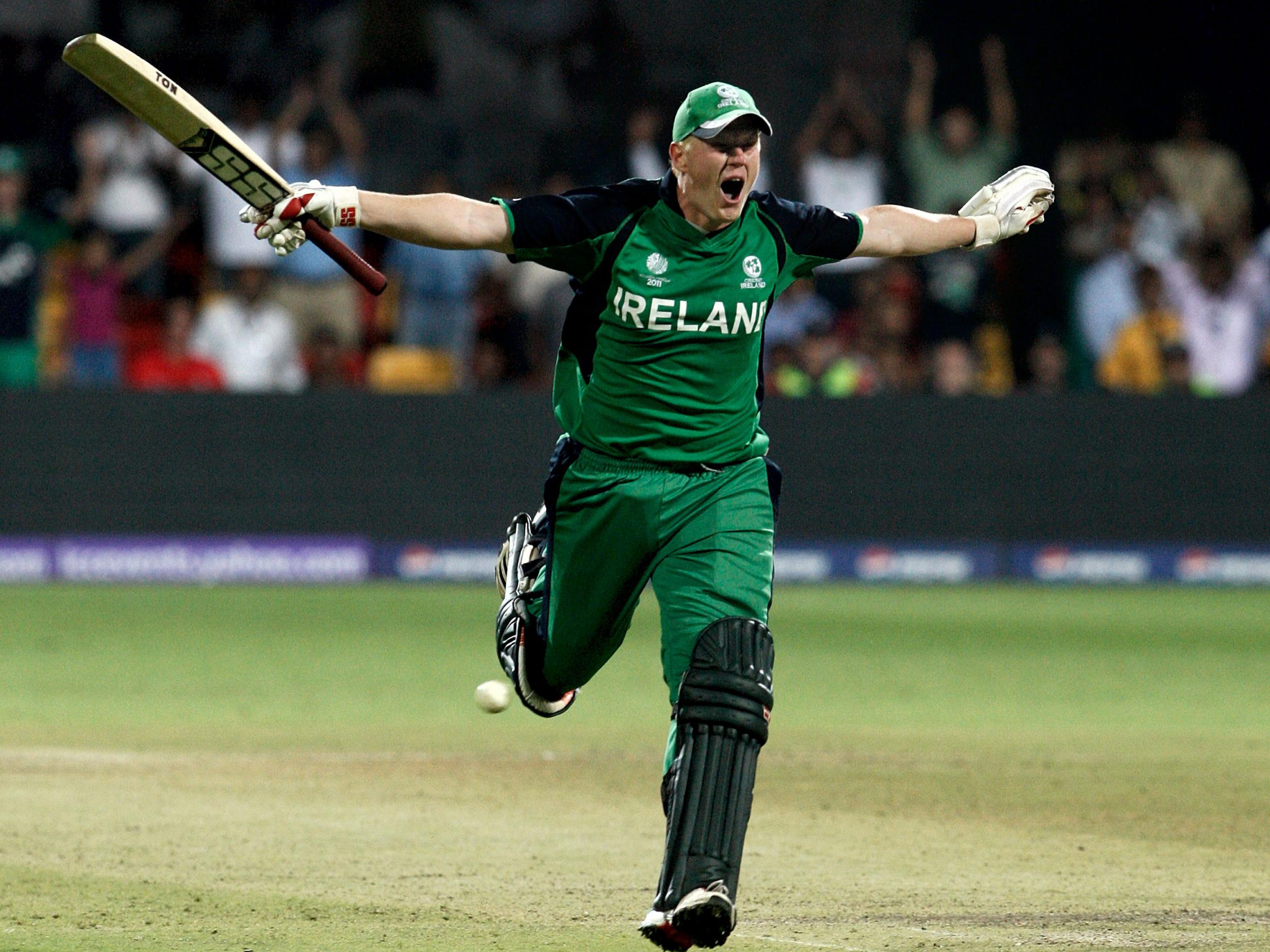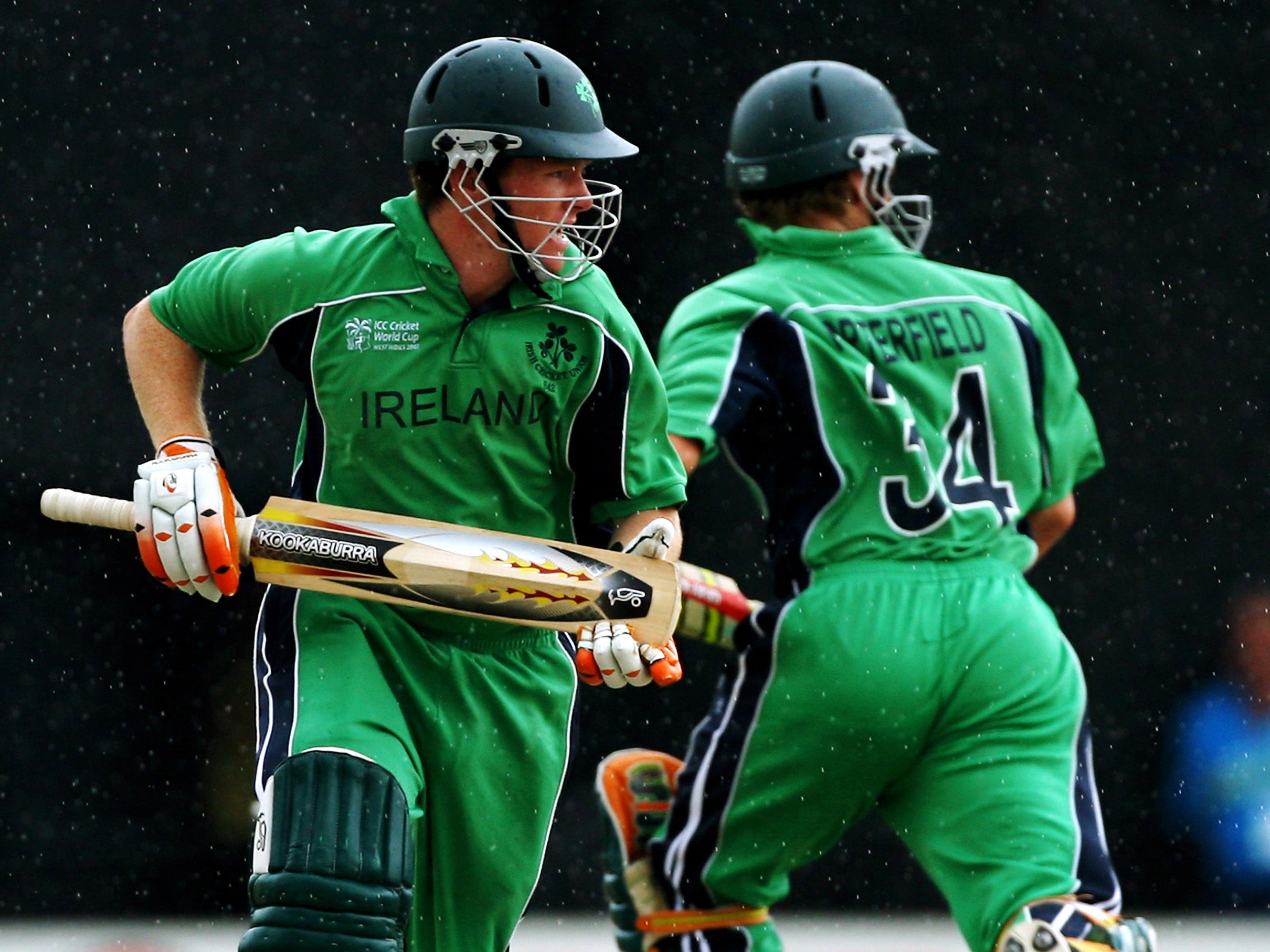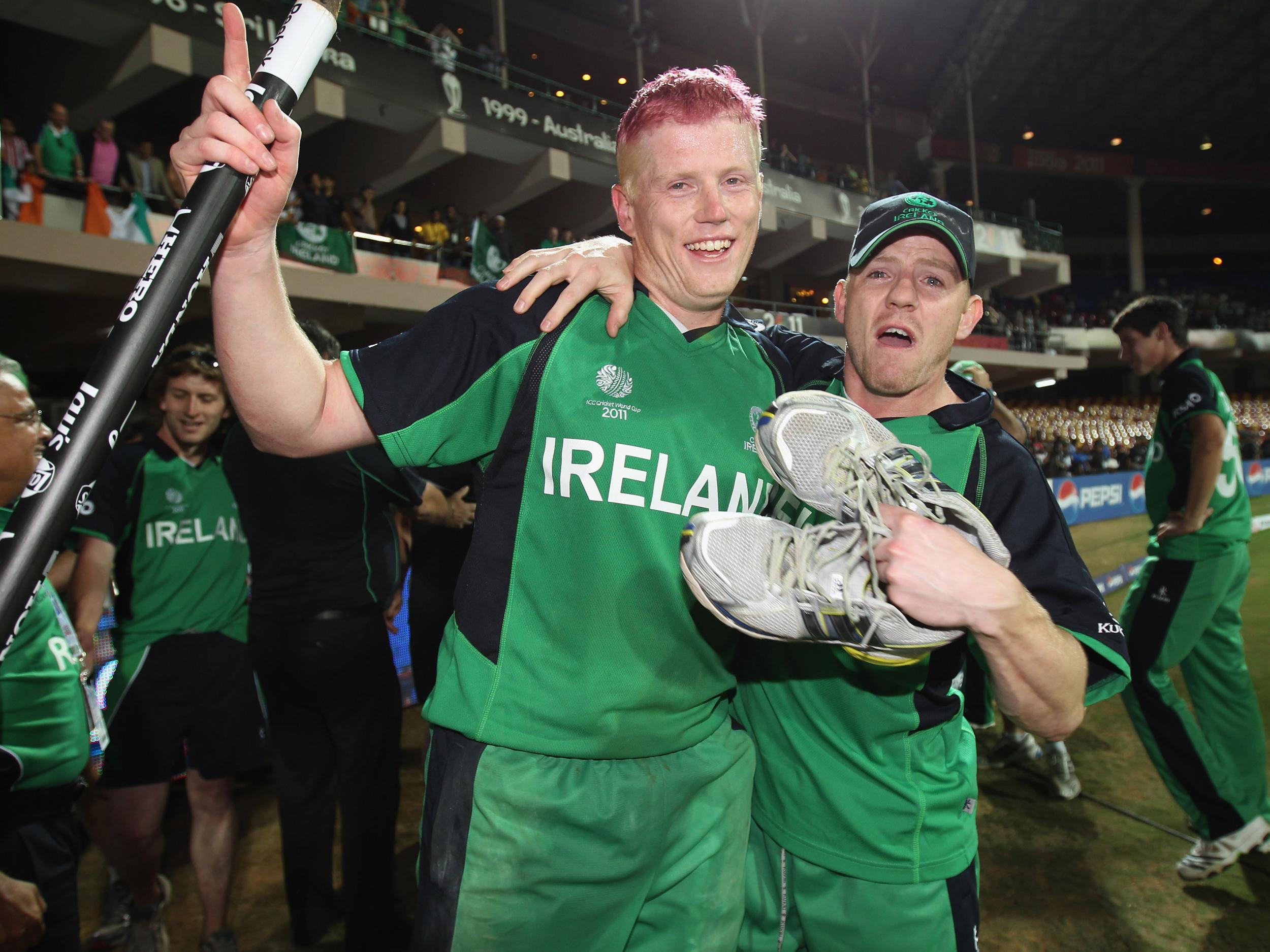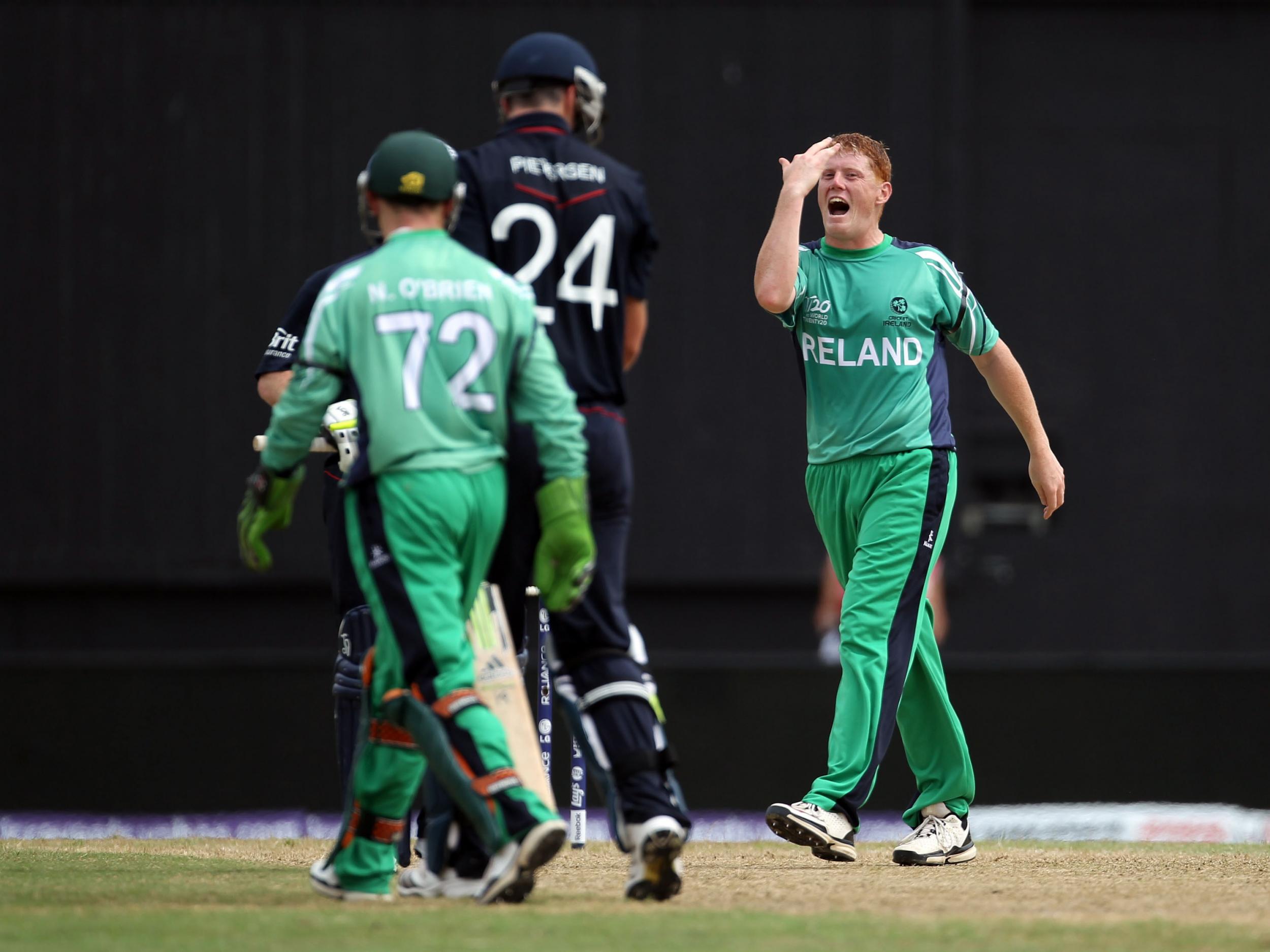England vs Ireland: From a 70-year ban to the verge of becoming a Test nation – A history of Irish cricket
Both the England and Ireland captain in Bristol on Friday will be Irish

Your support helps us to tell the story
From reproductive rights to climate change to Big Tech, The Independent is on the ground when the story is developing. Whether it's investigating the financials of Elon Musk's pro-Trump PAC or producing our latest documentary, 'The A Word', which shines a light on the American women fighting for reproductive rights, we know how important it is to parse out the facts from the messaging.
At such a critical moment in US history, we need reporters on the ground. Your donation allows us to keep sending journalists to speak to both sides of the story.
The Independent is trusted by Americans across the entire political spectrum. And unlike many other quality news outlets, we choose not to lock Americans out of our reporting and analysis with paywalls. We believe quality journalism should be available to everyone, paid for by those who can afford it.
Your support makes all the difference.In early 2004, Ireland had never played an official One-Day International, let alone made it to a World Cup. The Irish Cricket Union had one full-time member of staff, the national coach. His car boot doubled as the storage room for the team’s kit.
But Ireland also had a generation of young cricketers better than any they had ever produced. Among those who travelled to Bangladesh for the U-19 World Cup were William Porterfield, their captain and opening batsman; and his friend Eoin Morgan, their best batsman.
Thirteen years on from batting together for Ireland in the U-19 World Cup, the two will be reunited at Bristol on Friday: Porterfield leading out Ireland once more, while Morgan captains England.
At the start of 2007, Morgan and Porterfield arrived in the Caribbean for Ireland’s maiden appearance in the World Cup. The man that had done more than any other to help them there, Ed Joyce, had since been poached by England. Morgan was one of only two professional cricketers in Ireland’s squad.
Ireland resolved to overcome these limitations. Their mantra when bowling - ‘No no-balls, no wides and bowl straight at the stumps’ - was in keeping with the simple philosophy of Trent Johnston, an abrasive Australian who emigrated to Ireland, became captain and was unyielding in the standards he demanded.
The first World Cup game brought a helter-skelter tie against Zimbabwe, a game that neither side had known how to win. Two days later, Johnston won the toss against Pakistan on St Patrick’s Day, on a Jamaican pitch with an uncharacteristic green tinge.
As Johnston led his team into the field, they walked past a group of Pakistani supporters. “You should be back in the pub and you should be drinking Guinness,” they heckled the Irish players. “You don’t play cricket.”
When Pakistan had been bowled out for 132, Johnston went to every player in the Ireland dressing room, reminding them of the stakes if they lost: a return to their mundane existences as teachers, postmen and farmers. “I sure as hell don’t want to go back and sell fabric,” he told his team. For another four weeks, while Ireland competed in the Super Eights, where they would add a victory over Bangladesh, he did not have to.
After 275 years, Irish cricket had thrust itself onto the world stage. Cricket had been played in Ireland as far back as 1730; by the second half of the 19th Century, it was played in all 32 counties, by Catholics and Protestants alike, and was Ireland’s most popular sport.
Then it became a game confined to the shadows. Cricket suffered from emigration to cities, and from its own disorganisation. More than anything, it suffered because of the Gaelic Athletic Association. Formed in 1884, it sought to organise and popularise ‘Irish sports’ – principally hurling and Gaelic football.
“Our politics being essentially national, so should our athletics,” wrote Michael Cusack, the GAA’s founder. That bode ill for cricket.
In 1901, the GAA’s constitution formalised what its official guide referred to as ‘The Ban’. This prohibited the playing, or even watching, of ‘foreign’ sports like cricket: anyone who did not comply would be barred from playing in games organised by the GAA. For a new nation forging its identity, the quintessentially English nature of cricket made it abhorrent to nationalists.

The Ban remained until 1971, consigning cricket to a half-life. The sport survived but, outside small pockets, was caricatured as a game for Anglophile ‘West Brits’. And the national team, which had been able to compete with Test nations touring England in the early 20th Century, descended into a joke; its only regular fixture was an annual match with Scotland. When Test nations dropped by for friendlies, there was no need for a toss: the visitors would always bat first, to ensure play lasted the whole day. Half a century passed without any Irishman building a career in county cricket.
In 1993, Ireland became members of the ICC, and gained Associate status: the first step in Irish cricket moving from being an adjunct to the English game, a sort of glorified minor county, and instead becoming an independent cricket nation. In the years that followed, the Celtic Tiger brought men like Johnston to Ireland, raising the standard of club cricket. And after Joyce established himself for Middlesex in the early 2000s, counties took heed of the talent across the Irish Sea.
But the perception of cricket as an un-Irish sport lingered. Playing at school “you would have your bat nicked”, said Joyce, from a middle-class family in Bray, south of Dublin. “You'd be hiding your cricket gear on the train into town.” John Mooney, from a working-class family in Fingal, north of Dublin, “didn't tell anybody that I played cricket” when he was growing up. “The English thing was a big stigma.”
It turned out the best way to destroy this image was very simple: to beat England at their own game.
“I don't care if we never win another f***in’ match in our lives as long as we beat these bastards,” Mooney said when he was padded up in Bangalore in 2011 while Kevin O’Brien was eviscerating England to score the fastest hundred in World Cup history. When Mooney had sealed Ireland’s heist of 328, he exclaimed, fully audible on the live TV feed beaming throughout the world: “Best f***ing day ever!” Once like a secret society in Ireland, cricket was now on front pages throughout the land.
It was one of five victories that Ireland have recorded over Test nations in the last three World Cups - more than England. But even as Ireland advanced on and off the field - introducing professional contracts in 2009; creating a system of independent governance that ensured they were far better run than most Full Members; and setting up a new three-format interprovincial competition in 2013, which has just gained first-class status - they remained ostracised, given no chance to break into cricket’s cartel.
On a Tuesday in September 2013, Ireland even built a temporary stadium to house 10,000 people for a game with England at Malahide, and sold out every ticket. Ireland would have won too, but England’s top run-scorer and wicket-taker, Morgan and Boyd Rankin, were both Irish. “We don’t want our best players playing for England” read a sign in Malahide. “Irish cricket deserves better.”
Brían O’Rourke also deserved better. A native Irish speaker, he has worked in Irish underage cricket since 1998, introducing the sport to historically GAA areas as cricket development manager for Leinster. He also coached Ireland in three U-19 World Cups, including when Morgan and Porterfield played together in 2004.
“It’s very difficult to explain Irishmen playing for England to the average guy in the street,” O’Rourke says. “If we had another one who went it’d be catastrophic.”
When Morgan left for England in 2009 no one in Irish cricket was surprised. After an U-17 match at Oakham School, Paul Farbrace, then the England U-17 coach, spoke with Morgan. “He wasn't talking about the weather; he was talking about pursuing a career in England,” O’Rourke recalls. “It was very disappointing to see him leave but the decision he made was the right one - he's done remarkably well. Although he plays for England, he’ll always be remembered as an Irishman.”

Losing players to England was emblematic of the wider contempt with which cricket’s elite treated Ireland. When Ireland reached the Super Eights in 2007, knocking out Zimbabwe along the way, they received $56,000 in prize money for their performance in the Caribbean; Zimbabwe received $11 million, simply by dint of being a Full Member. From 2011 to 2015 World Cup, Ireland played a derisory nine ODIs against Test nations. And, impervious to their success in the tournament, the 2019 and 2023 World Cup will be cut to just 10 teams.
Ireland’s performances in the 2015 World Cup were imbued with anger. They recognised how the tournament gave them a chance to rail against injustice that they might not receive again; beginning with a thumping victory over the West Indies ensured that Ireland’s laments would be heard. When Ireland were eliminated - though only after winning three games, one more than England, leading to banners proclaiming them ‘Champions of Europe’ - the ICC's Twitter account lauded their "memorable and inspiring" campaign. “So memorable and inspiring that you have decided to cut the next WC to 10 teams,” replied Porterfield. “What is your vision for the game of cricket?”
Yet now there is sense that cricket’s governing elite are finally recognising the advances in the Emerald Isle. Last week, the ICC accepted the principle of admitting two new Full Members - Ireland and Afghanistan - to be ratified at the Annual Conference in June. Not only will Ireland become a Test nation, and get the financial benefits and full voting rights that come with the prize, but they will be included in the new 13-team ODI league, providing guaranteed fixtures against cricket’s elite nations. Rather than occasional games at short notice, Ireland will have a package of matches they can sell to broadcasters and commercial sponsors.
The reforms could double Ireland’s annual turnover, from €6 million to €12 million, believes chief executive Warren Deutrom. That will mean more can be invested in grassroots, Ireland’s leading players can be paid more without needing to play in county cricket, the domestic system can be improved and the fixture list for the A team, the women’s side and underage teams can be beefed up. In international sport, what happens in the boardroom can be even more important than what happens on the pitch. After a decade, Ireland have shamed the ICC into action, notwithstanding the myopic decision to contract the World Cup.
Yet there remains an inescapable irony: the sense that increased fixtures - Ireland are playing six ODIs in May alone, with a tri-series against Bangladesh and New Zealand following the England series - are coming at a time when Ireland’s team are in decline.
The side has endured the generational issues typical of national teams with small playing pools; since the 2011 World Cup, only one player, Andy Balbirnie, has broken into Ireland’s top seven. Retirements to Mooney and Johnston have deprived the team of nous with the ball and snarling in the field - the ‘bite, boot and bollock’ for which Irish sports teams are renowned. The injury to Rankin, now returned to Ireland, deprives the attack of pace and bounce. Ireland’s last performance, an innings defeat to Afghanistan in the Intercontinental Cup, was arguably their most disappointing since their breakthrough in the Caribbean a decade ago. County cricket has underpinned the development of Irish talent, yet there are now fewer Irishmen in county cricket - the national team’s burgeoning fixture list has made Irish players less attractive.
These are not trivial concerns. But nor do they obscure Ireland’s achievements.
Irish cricket has shed its elitist, Anglophile image. It is not a game for posh ‘West Brits’; it is a game for Protestants and Catholics, working-class and middle-class; native Irish boys and girls, Australian and South African expats and the growing numbers who hail from the Asian subcontinent too. “Bring your bats and your wickets as we have a great, emerging, cricket team,” the presiding officer said during an Irish citizenship ceremony last week.
“There’s a real sense that this Irish national team is representative of a new Ireland,” says Deutrom. “It’s a real snapshot of cross-sections of demographics, of religions, of backgrounds, histories and traditions in Ireland.” The late Martin McGuinness was an ardent cricket fan, and once dressed up as WG Grace to raise funds for charity. The squad for the England games includes seven players who hail from the Republic, and six from Northern Ireland.
Perhaps most heartening of all is the transformation in grassroots cricket. Participation has quintupled, from 10,000 to 50,000, since the 2007 World Cup. The Leprechaun Cup, a T20 hard-ball competition for boys and girls schools in Dublin that launched 10 years ago, now has almost 50 primary schools involved.

O’Rouke hopes that never again will he nurture a player who goes on to play for England. “People now have a pathway in Ireland. Anyone with vision, passion and drive will remain here.” While Ireland have long been sustained by the generation who played in the 2004 U-19 World Cup, which included O’Brien, Rankin and Gary Wilson alongside Porterfield and Morgan, O’Rouke believes Irish cricket is renewing itself: “there’s another batch of very good cricketers knocking on the door.” Foremost among these are two recent Twenty20 international debutants: Josh Little, a 17-year-old left-arm pace bowler who has interested Surrey; and Lorcan Tucker, a 360-degree keeper-batsman.
It has been a remarkable journey, yet those within Irish cricket are adamant that it remains incomplete. The governing body’s strategic plan is to make cricket a “mainstream sport”: recognition that its visibility is still far less than the ‘big four’ - football, rugby, hurling and Gaelic football. Their ambition is nothing less than to be the European New Zealand - “a model because they’re a similar sized population, they're a country in which cricket wouldn’t be the largest sport, they're also a smaller market across the sea from a much larger market,” Deutrom says. New Zealand Cricket have shared expertise, including in governance and the relationship between regional associates and the main board, and Ireland’s new participation director worked in New Zealand for eight years.
When they arrived in the Caribbean a decade ago, Ireland were patronised as a team of expats. Earlier this year, an Ireland ODI eleven contained 11 players born in Ireland for the very first time. Across the England and Ireland squads for the ODI series, there are 14 players born in Ireland - including both captains - compared to 13 in England, a testament to Ireland’s success nurturing their own players.
Playing an ODI series in England for the first time, “feels a real moment in time when we can hopefully puff out our chests as a team that’s arriving on the world stage,” Deutrom says. On his first day, in December 2006, he was “the chief and only executive” of an organisation whose office consisted of a corner with two desks and two computers in Sport HQ, a government building for minority sports; the room given to rowing, canoeing and Irish community games all dwarfed cricket. “It would have been faintly ridiculous,” to suggest that Ireland would ever play Test cricket, he says.
The notion of Ireland producing both captains for an ODI series in England would have seemed scarcely less absurd. “I’m personally very proud that I've contributed in some way towards their development as players and captains,” O’Rourke says. “We've all done our bit somewhere along the line.”
Not that O’Rourke will be in England when Morgan and Porterfield walk out to toss. “I'll be needed here. It's probably the busiest month of the year.” On the international pitch, in the ICC boardrooms and at grassroots level, the struggle to build Irish cricket continues.
Join our commenting forum
Join thought-provoking conversations, follow other Independent readers and see their replies
Comments